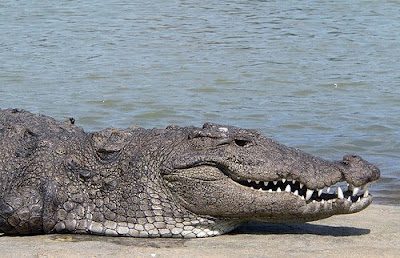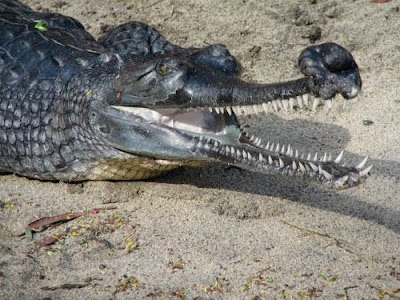Marsh crocodile, Mugger

Mugger crocodile belongs to the Crocodylidae Family and is scientifically known as Crocodylus palustris. Adult Mugger crocodiles of India are bright olive in color, while the young ones are on the paler side. The entire body is spotted with black and scaled. Outer toes as well as fingers are webbed at the base.
Common Names of Mugger
Mugger crocodiles of India are known by a number of other names also, like Iranian crocodiles, Marsh crocodiles, Indian Swamp crocodiles and Persian crocodiles.
Marsh crocodile is a freshwater species, which primarily occupies Indian lakes, rivers and marshes. It prefers slow-moving, shallower bodies of water and may be found in man-made reservoirs and irrigation canals also. Occasionally, the Mugger crocodiles of India may inhabit saltwater lagoons.
GHARIAL - GAVIALIS GANGETICUS

Common Names of Gharial
English: Indian gharial, Indian gavial, long-snouted crocodile. Hindi: Gharial. Bengali: Mecho kumhir. Oriya: Thantia kumhira, male: Ghadiala, female: Thantiana. Bihari: Nakar, Bashsoolia nakar.
Maximum reported length 6.75 m. Believed to attain a length of up to 8 m.
Northern India subcontinent: In India, they are found within the river systems of the Brahmaputra, the Ganges, and the Mahanadi, with small populations in the Kaladan.
Riverine - more adapted to an aquatic lifestyle in the calmer areas of deep, fast-moving rivers. The gharial is poorly equipped for locomotion on land. It usually only leaves the water to bask and nest, both of which usually occur on sandbanks.
Confined to the Indus, Ganges, Brahmaputra and the Mahanadi river systems in the Indian subcontinent. Once very common, increasing human use of rivers has restricted the gharial to a few remaining wild stretches of it former habitat. Presently the main habitat is the Chambal, Girwa, Rapti and Narayani rivers of the Ganges system. The species is now rare and endangered.
SALTWATER CROCODILE - Crocodylus Porosus

Common Names of Crocodylus Porosus
English: Saltwater Crocodile, Estuarine Crocodile. Oriya: Baula kumbhira, Kuji Khumbhiora. Hindi, Gujarat, Marathi: Muggar. Bengali: Kuhmir. Kannada: Mossalay. Tamil: Muthalai. Telugu: Moseli. Malayalam: Muthala, Cheengkani.
Probably the largest of the present day reptiles. The largest skull available measures 1 metre in length and it is believed to have belonged to a specimen of about 7 metres in length. Specimens over 5 m in length have been obtained in the Sunderbans and in Orissa river estuaries but are now exceedingly rare. A 4.5 m long captive specimen weighed 408 kg.
In India, the estuarine crocodile is restricted in its distribution to the tidal estuaries, marine swamps, coastal brackish water lakes and lower reaches of the larger rivers. The saltwater crocodile has a vast geographical range that extends from Cochin on the west coast of India to the Sunderbans in West Bengal and to the Andaman Islands. Single individuals can be found some distance from their usual range as they can travel long distances (over a thousand km) by sea. Barnacles have been found on the scales of a few stray individuals. This sea-faring ability probably helps to explain their wide distribution.